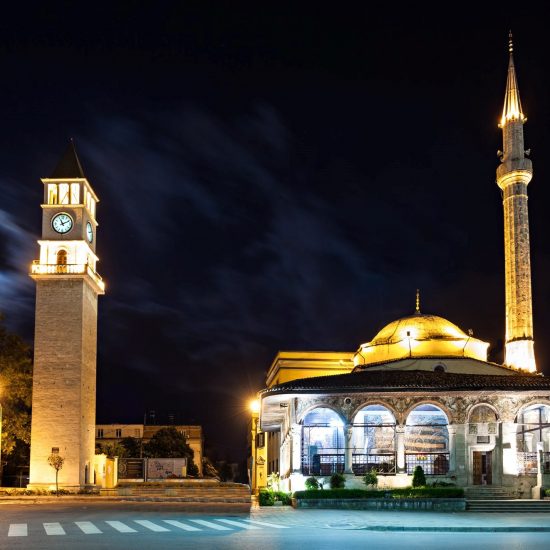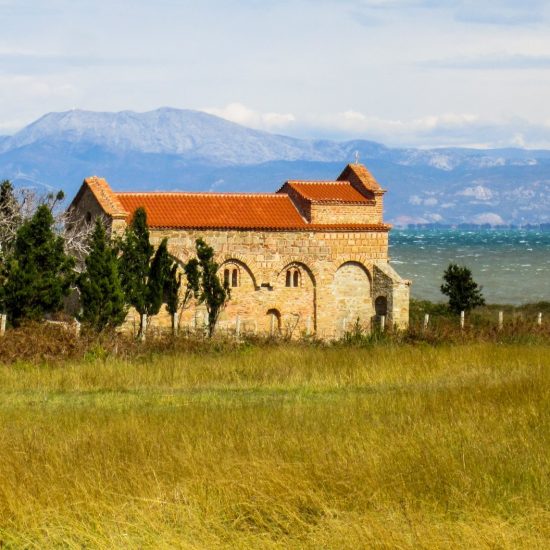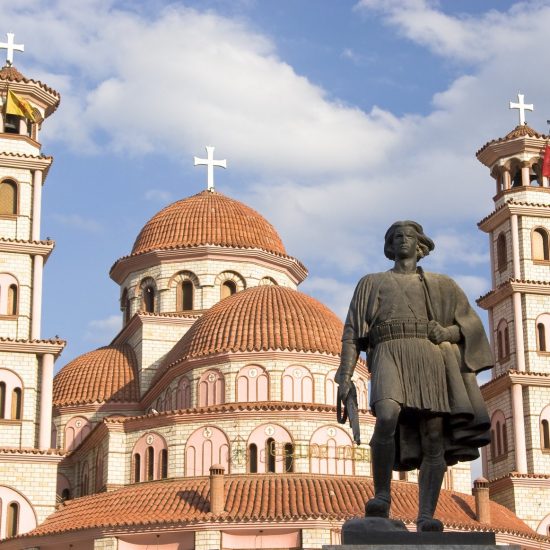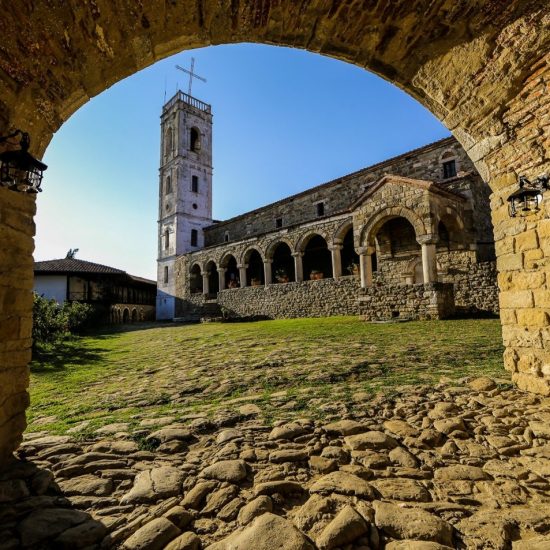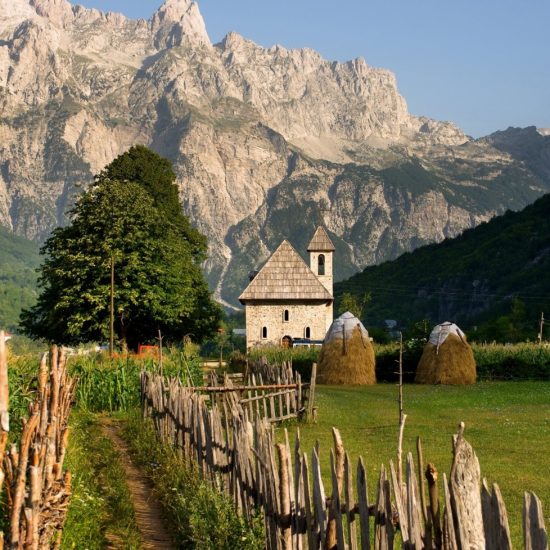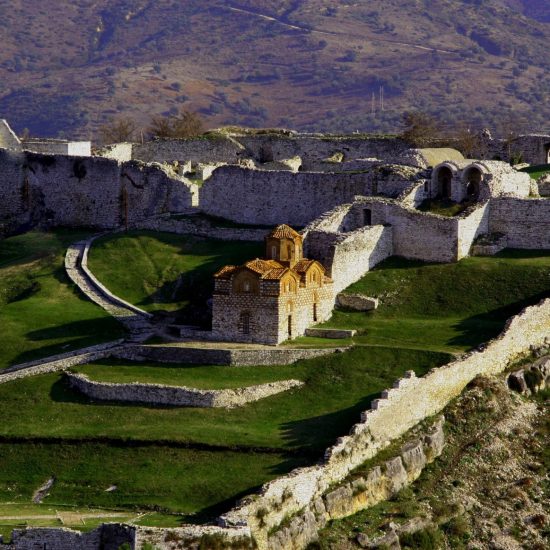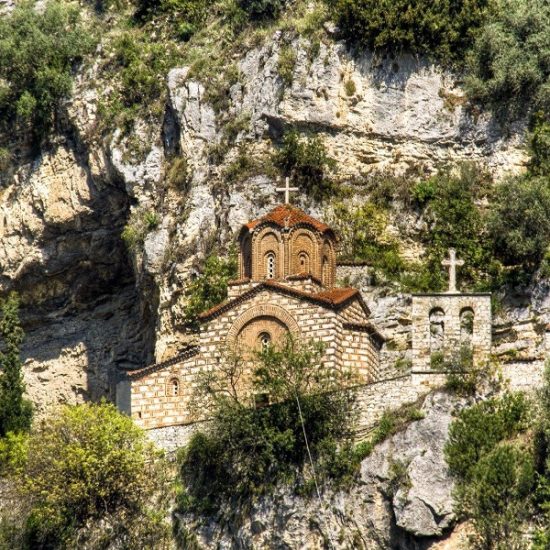The most common religion in Albania is Islam (predominantly Sunnis or Bektashi), the second most common religion is Christianity (predominantly Orthodox, Catholics and Protestants), however there are also many non-religious people. Albania is a unique religious tolerance that it has traditionally provided, with spiritual places originating from different religions. Although, perhaps, no other country in the world has seen such a peaceful coexistence of so many world religions. Some Religious Sites in Albania Bektashi World Headquarters in Tirana The Bektashi Path is a mystical path, the purpose of which is the improvement of the human soul. History shows that Bektashism was founded by the Sufi mystic Haji Bektash Velli in the 13th century. At one time he had 320 missionaries, whom he sent to various places throughout Anatolia and the Balkans. Because of their special hierarchy, the Bektashi (lodges) played an important role in the religious life of different parts of the world. The Bektashi Babas and Dervishes spread their mystical interpretation of Islam throughout Turkey, the former Yugoslavia, Greece, Albania and established a presence in Egypt, Iraq and Hungary. This value can be recognized in relation to the Bektashi for the fact that they look at their time, place and culture, with calmness and tolerance they face various problems of the world, helping in peaceful interaction with all believers. Catholic Church of the Heart of Christ in Tirana The oldest surviving Catholic church in Tirana is a Roman-style Jesuit church built by Giovanni Santi (from Udine in Italy) in 1939. In 1967, when any religious activity was banned in Albania, it was stripped of its frescoes and turned into a cinema. It reopened as a church in 1991 and the two chapels were repainted by Shpend Bengu in 1999. Visitors are greeted in the morning and afternoon. Church of St. Anthony near Lach Church of St. Anthony of Padua in Lach (Kisha e Shën Anoit) is located near the town of Lach, 3 km. The church was built in 1557 AD in honor of Saint Anthony of Padua, a Catholic saint who was born in Lisbon and died in Padua. This church is known for hosting the largest Catholic pilgrimage in Albania. The peak of the ceremony falls on June 13th. Church of St. Ristos, Mborje, Korca The Church of the Holy Resurrection (alb. Kisha e Ristozit) is a cultural monument of Albania, located in Mborje, Korca district. The church is dedicated to Saint Mary. Early Christian Basilica of St. Michael near Durrës Early Christian Basilica of Shën Mëhill (St. Michael) in Arapai: The ruins of the Basilica of St. Michael (Bazilika e Shën Mëhillit) were discovered during an archaeological expedition in 1974 AD, which took place 6 km. away from the modern city of Durres. The church is notable for its architectural style, which has three naves, an atrium on the west side and an impressive 54 m2 mosaic. The mosaic is almost intact and has been preserved in surprisingly good condition. Not far from the area, some sculptural objects of the 5th-6th centuries AD were found. Many excavated coins found in the area indicate that the settlement existed from the 5th to the 14th century AD. In 1081 AD Byzantine soldiers fleeing the Norman invasion sought refuge in the church, and therefore it was later burnt to the ground by the invasion of the Ethem Bej Mosque in Tirana This is the only still existing mosque of the eight mosques built in Tirana in the 18th-19th century. Its foundation was laid by Mollabey at the end of the 18th century, and the chapel was completed by his son Hadji Ethem-Bey in the first quarter of the 19th century. Molla Bey managed to build the dome of the mosque, having failed to complete the minaret, portico, plaster and decorate the walls of the mosque due to his death. His son Hadji Ethem Bay completed the roof of the mosque, built the porch and decorated the mosques with paintings and ornaments. The chapel was completed in 1236 (1820-1821) The main mosque in Shkodër Situated behind Rozafa Castle, the “Lead” mosque was built in 1773 AD. Mehmet Pasha Bushati and is one of the most prominent cultural and religious attractions of the city of Shkodra. Of particular importance is its architectural resemblance to the Blue Mosque in Istanbul. This distinguishes it from other mosques in Albania designed and built based on typical Arab architectural styles. Muradi Mosque in Vlora The Muradi Mosque is located in the very center of the city of Vlora. It is a Sultan-style mosque with a dome built in the second half of the 16th century AD. It consists of a prayer hall and a minaret built of carved stone. This memo has a harmonious distribution of windows. Mimar Sinan Aga the Great, an architect of Albanian origin who was one of the most important mosque builders in the Ottoman Empire, designed and built this mosque. He is considered the greatest architect of the classical period of Ottoman architecture, often compared to Michelangelo. Muradiye Mosque is the only building preserved from this master in Albania. Orthodox Cathedral in Korçë The Orthodox Cathedral of the Resurrection of Korçë was completely rebuilt in 1992 after the previous church on the site, St. George’s Cathedral, was destroyed by the communist authorities in 1968. Now the striking pink building is the largest church in Albania, and the second largest in the Balkans. A huge carved wooden iconostasis dominates the modest white interior. Also note the Albanian eagles carved into the chairs. Rubik’s Church Rubik’s Church is located on top of a rocky hill overlooking the small town of Rubik. The church is one of the most important religious monuments of the 12th-13th centuries AD. Its construction was completed in 1272 AD and served as a Benedictine abbey and a Franciscan monastery. Of particular value and importance are the Byzantine-style wall frescoes decorating the interior of the church. Church of Agios Athanas in Voskopia The Church of Agios Athanas (Shën Thanasi), together with the cemetery, is dated 1724 AD. The church was built by five masters from Kastoria. St. Mary’s Church in Libochov, Gorokaster St. Mary’s Church in Labov and Krikit has an inclusive cruciform style with a typical provincial Byzantine roof type. Inside, arches on two floors are used to support the roof, making reference to some of the churches in Constantinople. The date of occurrence has not yet been determined due to the lack of written documents, but oral evidence suggests that it dates from the 14th-18th centuries AD. This is also confirmed by the similarity with the churches in Kostur and Ohrid of that time. Church of St. Nicholas in Shelkane, Elbasan Church of St. Nicholas in Shelkane (Kisha e Shën Nikollës) is located in the village of Shelkan in the Shpaty region, southeast of Elbasan. Inside the church, there are valuable frescoes painted by Onufri, a famous Albanian painter of the 16th century AD. Monastery of St. Mary in Apollonia The archaeological site of the Monastery of the Blessed Mary in Poiana is located in the complex of the Apollonia Archaeological Park. It was built in the 13th century AD. By the end of antiquity, Apollonia was largely depopulated, the location of a small Christian community who built this monastery on a hill, probably on the site of the old city. It was reconstructed by the Byzantine emperor Andronicus Palaiologos II. The chapel was built in the Byzantine style. The Monastery of Saint Mary is one of the most beautiful buildings of its kind in Albania. Monastery of Saint Nicholas of Mesopotamia near Delvin The Monastery of Saint Nicholas of Mesopotamia is a wonderful landmark located in the village of Mesopotamia, near the tourist town of Saranda. It is quite accessible due to its location on the national road connecting Saranda with Gjirokastra. This is a Byzantine church, reconstructed twice in 1793 and 1843 AD. The main feature of the monastery is its distinctive defensive features. The fortified masonry surrounding the monastery includes rectangular towers. It attracts many visitors as it is located near the Butrint National Park. Monastery of St. Prodhom in Voskopia The monastery of St. Prodhom was built in 1632 and the church of St. Nicholas (Shen Kolli) in 1721. The famous icon painters David Selenikasi and the Zoografi brothers were engaged in the frescoes of the temple. The Red Mosque in Berat Castle. The remains of the Red Mosque are visible to the south of the upper fortress, near the western outskirts of the castle. This monument is believed to be a mosque, which Elvia Celebiu identifies as the mosque of Sultan Bayaziti when he wrote about the castle. The building contains a prayer hall with an almost square plan and forms an antechamber of the same width. On the left side of the hall is a minaret. This location, which is different from other mosques, seems to be due to the close proximity of the boundary wall to the southwest. The walls of the shrine, like the foundation of the minaret, are built of horizontal bricks and one or two vertical bricks between limestone stones. The date of the creation of the mosque is unknown, however, based on the data of Celebiu, the equipment used and its location, it can be concluded that the mosque dates back to the 15th century AD. Whether it was built by Sultan Bayaziti or an earlier structure, it is even more difficult to pinpoint an exact date. The Turkish garrison has been stationed here since the second half of the end of the 15th century AD. Church of the Holy Trinity in Berat Castle. The Church of the Holy Triada was built between the second half of the 13th century AD and the beginning of the 14th century AD. This is the finest example of inscribed cruciform domed churches. It consists of a naos supported by four pillars and a narthex built later. It has side wings made by a system of arches, and a dome in the center. The walls of the church contain stones, pieces of brick at the bottom and opus mixtum at the top. There are also wall paintings in the interior of the church. Church of St. Mitri in Berat Kisha e Shen Mitrit (Church of St. Demetrius) does not look very good, but still interesting. What stands here today was rebuilt on the remains of an old temple of the 16th-17th centuries; and the murals were painted in 1607. Later, a vestibule was built around the church on three sides. Inside the church has only a small naos and an altar. The church was built entirely of limestone and clay. The church can be found on Rrugik Shen Triadi, near Xhamia e Kuqe and Kisha e Shen Mitrit. Ilyaz Mirahori Mosque in Korce The Ilyaz Mirahori Mosque was built in 1484. This mosque is the oldest landmark of the city and stands out for its historical, cultural, religious and architectural values. It is located southwest of Fan Noli Boulevard. A number of pictures of Mecca and Medina hang on the walls. The minaret was damaged in an earthquake reported in the 18th century, but the apse has recently been characteristically rebuilt, also made of carved stone. Judging by the construction technique, size and architectural quality, the church dates from the 17th and 18th centuries. Church of St. Spyridon in Vuno Church of St. Spiridon according to the Data Service of Scientists 1778 St. Spiridon. s Vouno Church is a sub-group of flat-roofed basilicas, measuring about 19.80 x 11.40 m. It is fed by a central hall and porch, which are shown to the west. It is divided by two arcades on stone columns with three long naves. The roof of the May 3 church was temporarily demolished with frescoes. The King’s Mosque in Berat Built by Sultan Bayaziti II around 1480, the King’s Mosque, located in the complex, is one of the oldest in Berat. The mosque consists of a minaret, a hall and a portico, and many windows abundantly illuminate the entire interior of this object. The inside of the building is divided into two floors, whose architecture includes a soothing mix of columns, arches and colorful decorations. Another amazing element of its architecture is wood carving, which perfectly enriches the atmosphere of the interior. Tekke Halveti Tekke Halveti in the medieval center of Berat is another impressive monument in this complex and one of the city’s most interesting architectural structures. Tekke was built in the 15th century and restored by Ahmet Kurt Pasha at the end of the 17th century. St. Mary’s Church in Ardenica St. Mary’s Church (Kisha e Shën Mërisë), on the other hand, is the most impressive building on the site. This church, built with stones from the ancient city of Apollonia, welcomes anyone through an open porch, columns and arches. The height of the bell of this church is 24 meters! The interior of the church is decorated with beautiful frescoes, depicting scenes from the New Testament, by painters Kostadin and Athanas Zografi (originally from Korca) St. Mary’s Church in Ardenika St. Mary’s Church (Kisha e Shën Mërisë), on the other hand, is the most impressive building on the site. This church, built with stones from the ancient city of Apollonia, welcomes anyone through an open porch, columns and arches. The height of the bell of this church is 24 meters! The interior of the church is decorated with beautiful frescoes depicting scenes from the New Testament by the painters Kostadin and Athanas Zografi (originally from Korca) St. Mary’s Church in Ardenika St. Mary’s Church (Kisha e Shën Mërisë), on the other hand, is the most impressive building on the site. This church, built with stones from the ancient city of Apollonia, welcomes anyone through an open porch, columns and arches. The height of the bell of this church is 24 meters! The interior of the church is decorated with beautiful frescoes depicting scenes from the New Testament by painters Kostadin and Afanas Zografi (originally from Korca)
